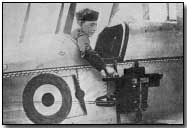Encyclopedia - Photo Reconnaissance
 With the onset of
trench
warfare from September 1914 on the Western Front increased value was
placed upon information enabling military strategists (most commonly local
commanders) to piece together the precise composition of the enemy's lines.
With the onset of
trench
warfare from September 1914 on the Western Front increased value was
placed upon information enabling military strategists (most commonly local
commanders) to piece together the precise composition of the enemy's lines.
To this end aircraft were at an early stage of the war despatched on aerial reconnaissance missions. Initially performed without the aid of photographic equipment the benefit of the latter rapidly became apparent (although long-range missions were later often conducted without photographic equipment). Consequently the first aerial photographs of the war are believed to have been taken by the British Royal Flying Corps (RFC), whose 3rd Squadron returned with pictures of = German lines on 15 September 1914.
Early photographic equipment was ill-suited to the task however. Airmen who operated the standard press cameras necessarily wore heavy gloves as a measure against freezing conditions, and the quality of photographs was often poor.
Thus new camera models were developed for use in 1915, manufactured by Thornton-Pickard for the British and Flieger Kammer for the Germans, who were similarly prompt in realising the potential benefits of photo reconnaissance.
Airmen sent on photo reconnaissance missions ran notable risks however. Necessarily flying at a low altitude in two-seater aircraft with the observer handling the camera - at least during the early stages of the war while camera equipment was being refined - they comprised straightforward prey for anti-aircraft artillery and pursuit aircraft.
Later in the war pilots flying far more efficient single-seater aircraft (pioneered by the Italians out of necessity when flying over the mountains of the Isonzo Front in aircraft such as the Ansaldo SVA) could take effective photos from fixed cameras from 10,000 and then 20,000 feet.
Photos developed from such missions were carefully studied for evidence of troop movements and industrial sites, the latter providing useful target information for subsequent bombing raids. The former could (and often did) provide early warning of an impending attack.
Click here to view a related article on this site.
Photograph courtesy of Photos of the Great War website
'Billy' was the Australian nickname for a cooking-pot or can.
- Did you know?
